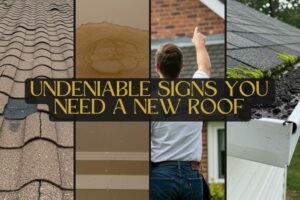As a home improvement expert with over a decade of experience helping homeowners across the United States, I can tell you that a roof is the silent guardian of your home. It bravely stands between your family and the harsh elements—baking sun, driving rain, heavy snow, and high winds. But just like any guardian, it can’t protect you forever. One of the most critical responsibilities of any homeowner is learning to recognize the signs you need a new roof before a small problem turns into a catastrophic and costly disaster.
A new roof is a significant investment, and the thought of roof replacement can be daunting. This uncertainty often causes homeowners to ignore subtle warnings, hoping they’ll just go away. Unfortunately, roof problems only get worse with time.
This comprehensive guide is designed to empower you with knowledge. We will walk through every clue, from the obvious red flags you can spot from the street to the subtle interior signs hiding in your attic. By the end of this article, you’ll be able to confidently assess your roof’s health and know exactly when it’s time to call in the professionals.
The First Clue: Your Roof’s Age and History
Before you even climb a ladder or step into your attic, the single most important indicator of your roof’s condition is its age. Every roofing material has an expected roof lifespan, and knowing where you are in that timeline is your first and most powerful clue.
How Long Should a Roof Last?
The roof lifespan varies dramatically based on the material used, the quality of the installation, and the climate you live in. A home in sunny San Diego will experience different wear patterns than one facing the harsh winters of Minneapolis.
Here’s a general guide to the expected lifespan of common roofing materials in the US:
- Asphalt Shingles (3-Tab): 15-20 years. These are the most common and affordable option but have the shortest lifespan.
- Asphalt Shingles (Architectural/Dimensional): 25-30 years. This is a much more durable and popular upgrade from standard 3-tab shingles.
- Metal Roofs (Steel, Aluminum): 50+ years. Metal roofing is a significant investment but offers exceptional longevity and durability.
- Wood Shakes/Shingles: 25-35 years. These offer a beautiful, natural look but require more maintenance.
- Clay or Concrete Tiles: 50-100+ years. Extremely durable and common in specific regions like Florida and the Southwest, tile roofs can last a lifetime.
- Slate: 100+ years. A slate roof is the pinnacle of longevity and can last for generations.
The Asphalt Roofing Manufacturers Association (ARMA) provides excellent resources on the durability and characteristics of various shingle types. If your roof is approaching the end of its expected lifespan, you should be on high alert for other warning signs.
Uncovering Your Roof’s Past
If you haven’t lived in your home since the last roof was installed, you may not know its exact age. Check the home inspection report from when you purchased the property; it often contains an estimate of the roof’s age and condition.
You can also look for records from the previous owner or contact the roofing company if a sticker or sign was left behind. If all else fails, a professional roofer can give you a very accurate age estimate based on a thorough inspection.
The Neighborhood Clue
One of the simplest and most effective ways to gauge your roof’s age is to look around your neighborhood. If your home was built as part of a development, chances are your neighbors’ homes were built around the same time with the same materials.
We worked with a client in a suburb of Raleigh, North Carolina, who noticed that three of her neighbors on the same block were getting new roofs within a few months of each other. This was the prompt she needed to have her own 22-year-old roof inspected, and sure enough, it was time for a replacement. If you see a wave of roof replacement projects in your area, it’s a very strong indicator that you should be paying close attention to your own.
Exterior Inspection
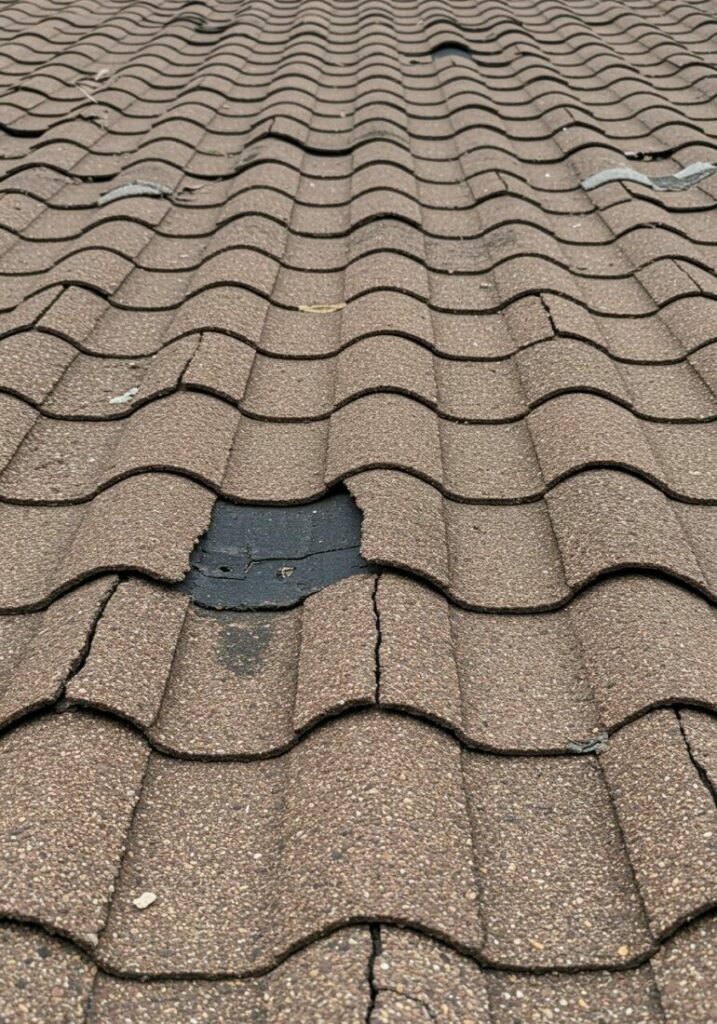
The most visible signs you need a new roof can often be spotted right from your driveway or yard. A quick visual inspection a few times a year can help you catch problems early.
Curling, Cracking, and Buckling Shingles
Asphalt shingles are designed to lie flat to properly shed water. When you see shingles that are starting to curl at the edges (a condition known as “cupping” or “clawing”) or buckle in the middle, it’s a clear sign of advanced wear.
This type of shingle damage is often caused by years of heat exposure from the sun and moisture from below in the attic. These distorted shingles are no longer sealed properly and can be easily torn off by the wind, leaving your home vulnerable.
Bald Spots and Missing Granules
Look closely at an asphalt shingle. That rough, sandpaper-like texture comes from a layer of ceramic granules. These granules are the shingle’s primary defense against the sun’s damaging UV rays.
As a roof ages, these granules begin to break away and wash into your gutters. If you see “bald” patches on your roof or a significant accumulation of what looks like black sand in your downspouts, it means your shingles’ protective layer is gone. They are quickly becoming brittle and ineffective.
Missing or Damaged Shingles
This is one of the most straightforward signs. After a heavy windstorm, it’s always a good idea to walk around your house and look for any shingles that may have been blown off.
A few missing shingles might be repairable, but it can also indicate a more widespread problem. It often means the adhesive seals on the surrounding shingles have failed, and the roof system is nearing the end of its life. We advised a client in a windy part of Kansas to opt for a full replacement after a storm tore off shingles in multiple sections, as a spot-repair would have been a temporary and unreliable fix.
Damaged or Rusted Flashing
Roof flashing refers to the thin pieces of metal (usually aluminum or steel) installed around chimneys, vents, skylights, and in the valleys of your roof. Its job is to create a watertight seal in the areas where the shingles meet a vertical surface.
If this flashing is cracked, bent, or rusted, it creates a direct pathway for water to enter your home. Damaged flashing is one of the most common sources of roof leaks.
Spongy or Soft Spots
This is a very serious sign of roof damage that indicates a structural problem. If you are walking on your roof (which should always be done with extreme caution) and notice a soft, spongy, or bouncy feeling underfoot, it’s a major red flag.
This almost always means the underlying wood sheathing has absorbed moisture and has begun to rot. A rotted roof deck cannot properly support the weight of the shingles or a person and requires immediate professional attention.
Interior Inspection
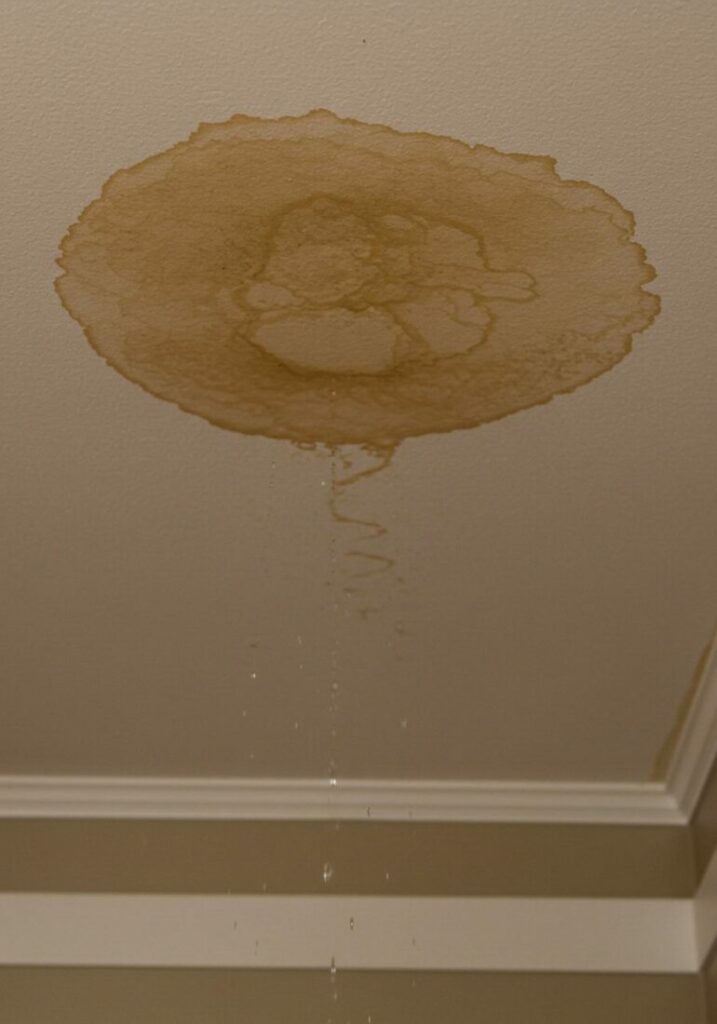
Some of the most definitive signs you need a new roof are not found on the outside of your home, but on the inside. A problem that has reached your interior spaces is often more urgent.
Image Prompt: A photo taken from inside a dark, dusty attic. A single, dramatic beam of sunlight is piercing through a small hole in the roof sheathing above, illuminating dust particles in the air. Dark, brownish water stains are clearly visible on the wooden rafters and insulation near the beam of light.
Leaks and Water Stains in the Attic
Your attic is the first line of defense after your roof. On a sunny day, safely pop your head into the attic and turn off your flashlight. Look up at the underside of the roof deck.
If you see any beams of light coming through, it’s an undeniable hole that needs to be addressed immediately. Also, scan the rafters, sheathing, and insulation for dark, brownish streaks or stains. These are the tell-tale signs of a roof leak, even if the leak hasn’t made it to your ceiling yet.
Stains on Your Ceilings and Walls
A water stain on the ceiling of your living room or bedroom is a classic symptom of a failing roof. Water can travel a long way from the initial point of entry, running along rafters and wall studs before it finally soaks through your drywall.
Don’t just paint over a water stain without investigating the source. It’s your home’s way of telling you there is an active problem that needs to be fixed.
Peeling Paint Near the Roofline
Moisture from a slow leak can get trapped in your walls and ceilings. This moisture can cause the paint to bubble, blister, and peel.
If you notice peeling paint on the walls or ceiling near the roofline, especially on the top floor of your home, it’s a strong secondary sign of a moisture issue that could be originating from your roof. Addressing the source of the moisture is a critical part of any successful home maintenance plan, which ultimately protects your home’s value and enhances its curb appeal.
The Problems Hiding in Plain Sight
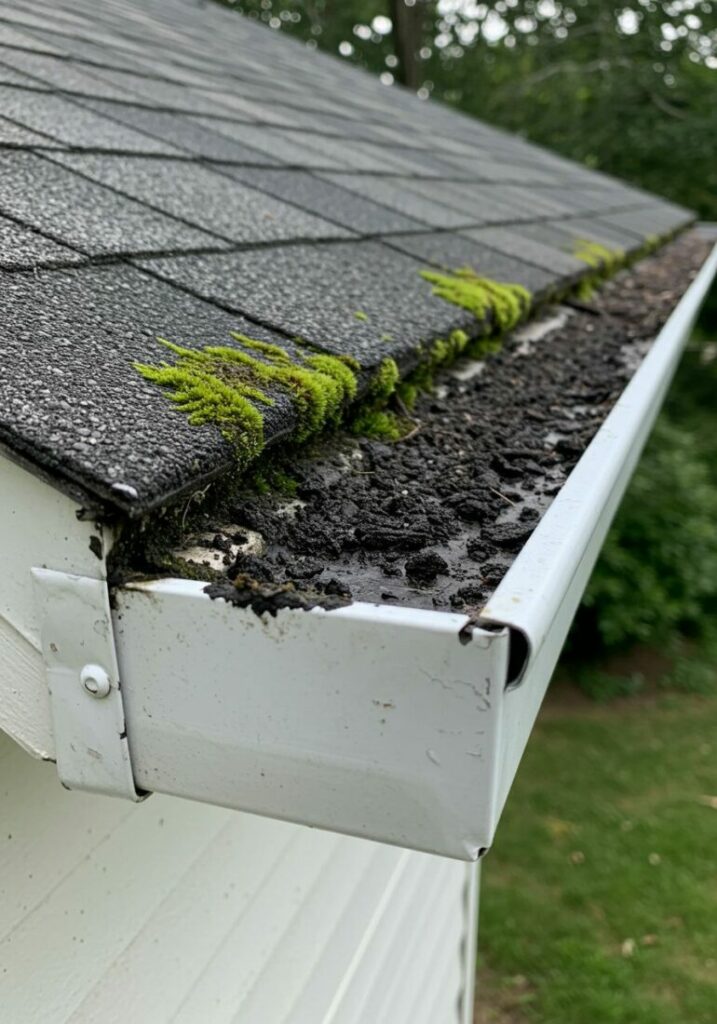
Sometimes, the evidence of a failing roof isn’t on the roof itself but in the areas surrounding it. These secondary clues can be just as informative.
An Avalanche of Shingle Granules in Your Gutters
We mentioned this earlier, but it bears repeating because it’s such an important sign. A small amount of granule loss is normal on a new roof, but if you are consistently cleaning a thick, gritty sludge out of your gutters, your roof is failing.
This “avalanche” of granules means your shingles have lost their protective UV coating and are rapidly deteriorating. This is a clear signal that a roof replacement is in the near future.
Algae, Moss, and Dark Streaks
Have you noticed dark, black streaks on your roof, particularly on the north-facing side? This is often caused by a type of airborne algae. While largely a cosmetic issue, it can detract from your home’s appearance.
The growth of moss, however, is a more serious concern. Moss holds moisture against the roof surface and can cause the edges of shingles to lift and curl over time, leading to rot. If you have significant moss coverage, it’s a sign that your roof is retaining moisture and should be professionally inspected.
A Sagging Roof Deck
Stand back on your street and look at the lines of your roof. Are they straight and level, or do you notice a dip, curve, or sag in the middle of the roofline?
A sagging roof is a sign of a major structural problem. It can be caused by rotted decking, saturated insulation, or even failing rafters. This is a serious issue that requires immediate attention from a qualified roofer or structural engineer.
Rising Energy Bills
Your roof is a critical part of your home’s thermal envelope. A well-insulated and ventilated attic helps keep your home cooler in the summer and warmer in the winter.
As a roof system ages and deteriorates, its insulating properties can be compromised. If you’ve noticed a sudden and unexplained spike in your heating or cooling bills, a failing roof and poor attic ventilation could be contributing factors.
What to Do When You Spot the Signs
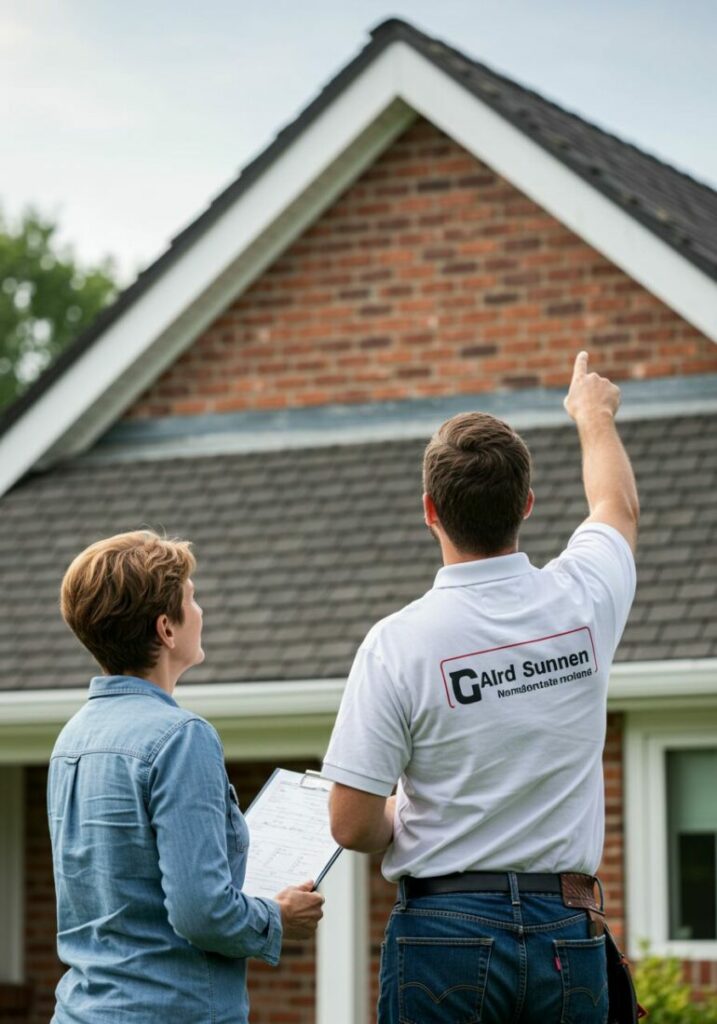
Okay, you’ve used this guide and identified one or more of these warning signs. Don’t panic. Here is a clear, step-by-step action plan to take control of the situation.
Document Everything
Before you make any calls, grab your smartphone and take clear photos of all the signs of damage you’ve found. Get pictures of the curling shingles, the granules in the gutters, the water stains in the attic, and the spots on your ceiling.
This documentation will be incredibly valuable when you’re talking to roofing contractors and is essential if you plan to file an insurance claim for storm damage.
The Importance of a Professional Roof Inspection
While your own inspection is a great first step, it’s no substitute for a professional assessment. A qualified roofer has the training and safety equipment to get on your roof and perform a thorough, hands-on inspection. For an idea of the comprehensive standards professionals follow, you can look at the resources provided by organizations like the International Association of Certified Home Inspectors (InterNACHI).
They can identify issues you might miss and give you an expert opinion on the remaining lifespan of your roof. Most reputable roofing companies offer free inspections and estimates.
Repair vs. Replace: Making the Right Call
The big question is always whether you can get away with a simple repair or if you need a full replacement. The answer depends on the age of your roof and the extent of the problem.
A small, isolated issue on a relatively new roof (like a few shingles blown off in a storm) can often be repaired. However, if your roof is over 20 years old and is showing widespread signs of wear like curling shingles and heavy granule loss across multiple sections, a full roof replacement is almost always the more cost-effective and safer long-term solution.
The Sign Severity Table
| Sign of Damage | Typical Severity | Likely Action Required |
| A Few Missing Shingles (Newer Roof) | Low | Repair |
| Granules in Gutters (Heavy) | High | Replacement (Roof is at end of life) |
| Curling or Cracking Shingles (Widespread) | High | Replacement |
| Damaged Flashing Around Chimney | Moderate | Repair (If isolated, otherwise part of replacement) |
| Small, Isolated Leak (Newer Roof) | Moderate | Repair |
| Daylight Visible in Attic | Severe | Immediate Repair/Likely Replacement |
| Sagging Roofline | Severe | Immediate Professional Inspection / Replacement |
| Roof Age Exceeds 25 Years | High | Proactive Replacement is recommended |
Planning for a Major Home Improvement
There’s no sugarcoating it: a new roof is a major expense. However, it’s also one of the most important investments you can make in the safety and value of your home.
Start by getting at least three detailed quotes from reputable, insured local contractors. When planning for such a large project, it’s wise to explore all your financial options, which is a key part of any major home renovation, similar to when homeowners consider how to finance a kitchen remodel.
Conclusion
Your home’s roof is constantly communicating its health to you through a series of clear and undeniable signals. Being an observant and proactive homeowner is your single best defense against the stress and expense of a sudden, catastrophic roof failure. By learning to recognize these common signs you need a new roof, you can move from a position of anxiety to one of empowered confidence.
From the age of your shingles to the state of your gutters and the integrity of your attic, the clues are all there. Use this guide to perform your own assessment, and don’t ignore the warnings your home is sending you. A small issue that is caught today can save you from a major disaster and a much larger headache tomorrow.
Take the next step. If you’ve seen any of these signs, call a qualified, reputable professional for an expert opinion. Your peace of mind and the long-term health of your home are worth it.
